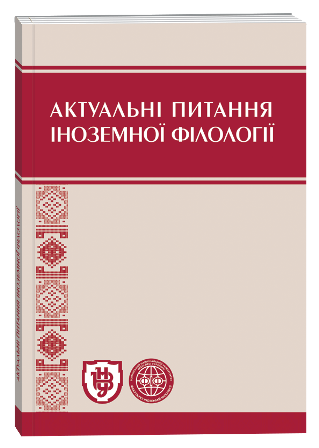PART LANGUAGE ORGANIZATION OF THE LEXICO-SEMANTIC FIELD OF TIME IN CONTEMPORARY ENGLISH
Keywords:
time, temporality, microfield, lexico-semantic field, lexical-semantic variant, seme, polysemyAbstract
The article analyzes the temporal orientations of the lexical units of contemporary English according to the part-language criterion. Although a lot of works are devoted to the study of units with temporal semantics, in particular the study of lexical time units of the English language field in the system of linguistic means and the attempts by linguists to characterize all language means with temporal semantics are fixed, the problem remains relevant and open to research. The purpose of this article is to study the philosophical category of time and its linguistic expression. To achieve the goal it is necessary to find out the place of the philosophical category of time in the language expression and to determine the temporal aspect of all parts of the language in the lexico-semantic system of modern English. The method of the continuous sampling highlightens 543 lexical units with a seme of time (196 nouns, 117 adjectives, 102 adverbs, 81 verbs, 36 prepositions, 11 conjunctions). The kernel of the lexico-semantic field of time consists of 276 lexical units: 102 nouns, 45 adjectives, 53 adverbs, 49 verbs, 24 prepositions and 4 conjunctions. According to the semantic criterion, the lexical-semantic field of time splits into 6 lexical-semantic microfields (noun, adjective, adverbial, verb, prepositional, and conjunctional). On the basis of the criterion of semantic closeness in each lexical-semantic microfield there is a certain number of lexical-semantic groups. The distribution of lexical units with a semes of time is based on the criterion of semantic proximity and semantic content.The semantic structure of the temporal words looks like a series of circles that touch each other and partly overlap on one another, which gives us the opportunity to speak about the interpenetration of individual temporal meanings.
References
Арнольд И. В Основы научных исследований в лингвистике : учеб. пособ. / И. В. Арнольд. – М. : Высш. шк., 1991. – 140 с.
Арнольд И. В. О применении табличного метода анализа в семасиологических исследованиях / И. В. Арнольд // Науч. докл. высш. шк. филол. науки. – 1967. – № 4. – С. 56–63.
Вежбицкая А. Язык. Культура. Познание / А. Вежбицькая ; пер. с англ. / отв. ред. М. А. Кронгауз, вступ. ст. Е. В. Падучевой. – М. : Рус. словари, 1996. – 416 с.
Вердиева З. Н. Семантические поля в современном английском языке / З. Н. Вердиева. – М. : Высш. шк., 1986. – 120 с.
Левицкий В. В. Экспериментальные методы в семасиологии / В. В. Левицкий, И. А. Стернин. − Воронеж : Изд-во Воронеж. ун-та, 1989. − 192 с.
Медникова Э. М. Проблемы и методы исследования словарного состава : автореф. дис. … канд. филол. наук : 10.02.04 / Э. М. Медникова. – М., 1972. – 31 с.
Моисеев А. И. Единицы времени и их выражение в современном русском языке / А. И. Моисеев // Biuletyn fonographicy. – Poznań, 1973. – C. 100–106.
Нильсен Е. А. Лексико-семантическое поле звукообозначений в английском языке (синхронный и диахронный аспекты) : дис. … канд. филол. наук : 10.02.04 / Е. А. Нильсен. – СПб., 2001. – 233 с.
Попова З. Д. Лексическая система языка: внутренняя организация. Категориальный аппарат и приемы изучения : учеб. пособ. / И. А. Стернин. – Воронеж : Изд-во Воронеж. ун-та, 1984. – 148 с.
Рудометкина М. И. Слова категории времени (на материале английского языка) : дис. … канд. филол. наук : 10.02.04 / М. И. Рудометкина. – Киев, 1972. – 233 с.
Селіванова О. Сучасна лінгвістика: термінологічна енциклопедія / О. Селіванова. – Полтава : Довкілля-К, 2006. – 716 с.
Harrap’s Standard Learner’s Encyclopedic Dictionary: Harrap Books LTD, 1990. – 542 p.
Longman Dictionary of Contemporary English. − 2001. – 1668 p.
Оxford Advanced Learner’s Dictionary. − Oxford : University Press, 1997. – 1430 p.
Downloads
Published
How to Cite
Issue
Section
License
Copyright (c) 2025 Наталія Канонік

This work is licensed under a Creative Commons Attribution 4.0 International License.







